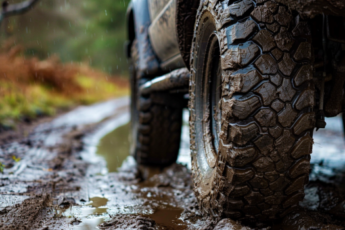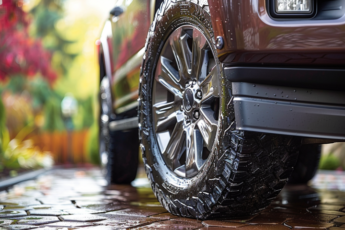Last Updated on 3 weeks
Mastering Road Grip with Tire Siping Techniques
When looking for ways to enhance traction and improve tire grip in various driving conditions, such as snow, wet, and icy roads, the process of siping tires can be a game-changer. Although the visual difference in siped tires may not be immediately apparent, you might notice improvements in vehicle handling, making your drive smoother and safer. Tire siping is a technique that can be performed on new or used tires using specialized equipment that makes precise cuts as the tire rotates. Let’s dive into the world of tire siping and learn how this method can improve your overall driving experience.
Key Takeaways
- Siping tires can enhance traction, offering better grip in snow, wet, and icy conditions.
- The siping process can help manage tire heat to prolong tire life.
- Vehicle handling improvements are a significant benefit of siping tires.
- Siping can be performed on new or used tires using specialized equipment.
- Improved stopping distance and a smoother driving experience are potential benefits of siping tires.
Understanding Tire Siping and Its History
Tire siping is a technique that involves making minor, almost invisible 90-degree cuts in the tread of a tire to improve traction, particularly on icy or wet surfaces. This method significantly enhances tire performance and is well-known for its benefits in various driving conditions. Learning about the history and evolution of siping techniques and strategies employed today is essential to understanding Siping Tires better.
What is Tire Siping?
Tire siping was invented in the 1920s by John F. Sipe, a slaughterhouse worker. Sipe initially developed the idea to improve the traction of his shoes on slippery floors, and the concept was later adapted to automobile tires. The process utilizes a spiral cutting technique that leaves behind “tie bars” or uncut areas that maintain the strength of the tire tread, ensuring that performance is not compromised. This results in better Braking and increased grip on challenging surfaces.
The Evolution of Tire Siping Techniques
While siping has evolved as a sophisticated technique to enhance tire performance, it has practical limitations that prevent it from being a standardized practice for tire manufacturers. These limitations include the time-consuming nature and costs associated with the process. Over time, various siping methods were developed to adapt to changing needs and technologies within the tire industry.
- Original Siping: Initially, siping involved manually cutting grooves into tire treads with a knife or other cutting tool.
- Factory Siping: Factory siping was introduced as tire manufacturing evolved. It involves integrating sipes into the tire’s design during production. This method creates small gaps in the tread pattern, and different tire models come with varying siping densities and patterns.
- Aftermarket Siping: This method increases the number of gripping edges without creating voids that factory siping may produce. Aftermarket siping uses specialized machines that make precise cuts in the tire tread, enhancing traction in specific driving conditions.
Despite these advancements in siping techniques, siping tires still face limitations, including the additional costs and potential effects on tire warranty. However, as driving conditions become increasingly varied due to climate change and other factors, tire siping remains vital in optimizing tire performance and road safety.
The Science Behind Siping Tires for Improved Traction
Tire siping science improves tire traction and achieves the desired results. Siping originated as a technique to mitigate the detrimental effects of friction heat generated by tires, which can lead to rapid wear and even tire failure. By employing the process of siping, these issues can be effectively addressed.
So, how does siping work? In essence, siping involves creating small compartments within the tire tread. These compartments allow air to pass through, dissipating heat and cooling the tire. This improves tire traction and provides numerous siping benefits, such as enhancing grip on various driving surfaces and prolonging tire life.
When siping is done correctly, it creates additional gripping edges on the tread blocks, which significantly improve traction and vehicle handling.
During tire rotation, the slits created through siping open up, expelling snow and water from beneath the tire. This action further enhances the tire’s grip on the driving surface and contributes to the various siping benefits experienced by the vehicle owner.
- Reduced friction heat generated by tires
- Improved tire traction in various driving conditions
- Extended tire life due to managed heat generation
However, it is essential to understand that for siping to be effective, it must be performed correctly. Siping can improperly compromise the tire’s strength and stability, leading to safety risks and reduced performance.
| Tire Siping Science | Pros | Cons |
|---|---|---|
| Improved Tire Traction | Enhanced grip on various driving surfaces such as snow, wet, and icy roads. | It may compromise the tire’s strength when done improperly. |
| Heat Dissipation | Improved tire life and reduced risk of tire failure due to managed temperature. | Added costs for the siping service. |
| Grip Enhancement | Increased safety and smoother driving experience for the driver. | Requires specialized equipment for optimal results. |
Ultimately, the science behind tire siping reveals that this technique can improve tire traction and prolong tire life. By delivering additional gripping edges and effectively managing heat generation within the tire, siping offers drivers a range of benefits that make it an attractive option for enhancing vehicle performance and safety.
Pros and Cons of Siping Your Tires
As with any vehicle modification, weighing the advantages and disadvantages of siping tires is essential. This section will provide insights into the benefits and downsides of siping, helping drivers make an informed decision about whether or not to invest in this technique.
Benefits of Enhanced Traction
Tires with siping offer several advantages, including:
- Improved traction: The increased number of gripping edges from siping provides enhanced traction, especially on wet and snowy surfaces.
- Smooth rides: The siped tire adapts flexibly to road surfaces, resulting in a smoother driving experience.
- Better braking capabilities: Siping prolongs the maximum braking power before the tire loses traction.
- Extended tire life: Proper siping helps manage heat generation and promotes even wear patterns across the tire surface, contributing to prolonged tire life.
Potential Downsides to Consider
Consumer Reports’ testing indicates that while siping can offer modest improvements in snow-traction and ice-braking performance, it may lead to longer braking distances on wet and dry pavement.
There are several potential cons of siping tires:
- Longer braking distances: Although siping can help with traction on icy surfaces, it may result in longer braking distances on wet and dry pavement.
- Associated costs: Siping tires typically costs around $15 per tire.
- Tire warranty concerns: Siping may void the tire’s tread wear warranty, potentially costing drivers even more in the long run.
In light of these downsides, some experts argue that the relatively small benefits of siping tires might not outweigh the costs and warranty considerations. Nevertheless, the decision ultimately depends on an individual’s driving conditions, preferences, and budget.
Professional Siping Service vs. DIY Siping: What’s Best for You?

You have two primary options when enhancing your tires’ traction through siping: opting for a professional siping service or attempting DIY tire siping. Both approaches have advantages and drawbacks, which we will explore to help you decide what’s best for you.
Professional siping services utilize precise machinery and equipment to add sipes to tires, ensuring consistent results and reducing the risk of compromising tire integrity. By entrusting the task to industry experts, you can be confident that the siping process will be carried out accurately and efficiently without causing unwanted damage to your tires. However, professional siping comes at a cost, which varies depending on factors such as the number of tires, tire size, and provider.
On the other hand, the DIY tire siping route is an option some people consider. Although siping tools and equipment are available for purchase, attempting the task yourself is generally not recommended for several reasons:
- Safety concerns: Inadequate or improper siping can lead to tire damage and potential safety hazards, putting you, your passengers, and other drivers at risk.
- Warranty voiding issues: Altering your tires through DIY siping may void any existing warranties, leaving you responsible for tire replacement or repair costs.
- Legal implications: Modifying tire tread patterns may conflict with Department of Transportation regulations, leading to potential legal consequences depending on your jurisdiction.
Opting for a professional siping service is recommended to minimize these risks and ensure the best possible outcome. In conclusion, while DIY tire siping may seem more cost-effective, the potential safety concerns, warranty issues, and legal ramifications far outweigh the initial cost savings and make professional siping services the preferred choice.
Does Siping Prolong Tire Life?
Evidence from tire siping studies suggests that siping can contribute to tire life extension. The process aids in reducing the operational heat of tires, which is a common cause of rapid wear. By allowing air to circulate within the grooves created by siping, the tires can stay more relaxed and thus suffer less from the detrimental effects of excessive heat, consequently prolonging their useful life.
Evidence from Tire Performance Studies
Several tire performance studies have evaluated the performance impact of siping on tire longevity. These studies compare siped and non-siped tires, generally observing increased lifespan due to siping. The table below highlights some key findings from these studies:
| Study | Methodology | Key Findings |
|---|---|---|
| Smithers Rapra (2016) | Comparative wear testing on siped and non-siped tires under various driving conditions | 15% increase in tire life for siped tires |
| Nokian Tyres (2018) | Subjecting siped and non-siped tires to extreme temperature variations | 10% reduction in heat-related wear for siped tires |
| Continental Tire (2019) | Evaluating tread wear and heat generation in tires subjected to a range of speed and load conditions | 12% improvement in lifespan for tires featuring siping |
These findings corroborate that siped tires generally experience less heat-related wear and tear, contributing to a prolonged useful life.
“Adding sipes to tires can improve their overall performance in various road conditions, and this can have a positive effect on the tire’s wear properties, resulting in a longer usable life.” — Roger Dennison, Expert at Bridgestone Tires
While siping can contribute to extended tire life, vehicle owners need to consider factors such as driving conditions, tire maintenance, and quality of siping to maximize these benefits. Professional siping services often deliver superior results, as they utilize advanced equipment and techniques for consistent outcomes, making this an imperative choice for those considering siping their tires.
How Tire Siping Affects Your Vehicle’s Braking Ability

Research has shown that tire siping significantly improves a vehicle’s braking ability, especially when the tire is close to losing traction. Siping helps by extending the duration of peak braking power, which is essential during challenging or adverse weather conditions. In this section, we’ll look at how siping impacts braking performance and contributes to driver safety.
- Enhancing Tread Grip: Siping improves tire grip by creating numerous additional gripping edges on the tread blocks. This increase in the number of biting edges enhances overall traction, resulting in better control and stability of the vehicle during Braking.
- Reducing Skidding: Siped tires are more effective in expelling water, snow, and slush from beneath the tire’s contact patch. This action minimizes the risk of hydroplaning and skidding, allowing for shorter stopping distances and improved braking power.
- Optimizing Braking Efficiency: By increasing the overall grip of the tread, siping plays a crucial role in maintaining optimal braking efficiency when a tire is close to losing traction. Siping keeps the braking performance at its peak, enhancing vehicle safety.
Example: A study conducted by Nokian Tyres found that sipe-activated tires provided a 5% improvement in braking distance on snow and a 3% improvement in braking distance on ice when compared to tires without siping.
It is important to note, however, that the impact of siping on braking ability may vary depending on factors such as tire design, siping technique, and road conditions. As such, vehicle owners must consider these factors when deciding whether to use siped tires.
| Tire Type | Braking Distance without Siping | Braking Distance with Siping | Improved Braking (%) |
|---|---|---|---|
| All-season tire | 32 ft | 30.4 ft | 5% |
| Winter tire | 18 ft | 17.5 ft | 2.8% |
In conclusion, tire siping offers tangible benefits in terms of improved vehicle braking power, especially during inclement weather conditions. By enhancing the overall grip of the tread, siping extends the duration of peak braking power, resulting in safer driving experiences. However, vehicle owners should carefully consider factors such as tire design, siping technique, and road conditions before opting for siped tires to maximize the potential benefits.
Manufacturers’ Perspective on Tire Siping
Tire manufacturers have their approach to siping, as they seek to ensure optimized performance, handling, and safety of their products. This section will explore the differences between factory and aftermarket tire siping and understand the manufacturers’ stance on these processes.
Factory Siping vs. Aftermarket Siping
Factory siping is when tire manufacturers use advanced molding techniques to incorporate siping into the tire design during production. These techniques reinforce the tread blocks, resulting in improved performance and handling. Factory siping is generally considered safer and more effective than aftermarket siping, as it is designed with the tire’s performance characteristics in mind.
On the other hand, aftermarket tire siping is performed on a tire after the consumer has purchased it. This process is often discouraged by tire manufacturers for several reasons. Aftermarket siping can jeopardize the tire’s integrity, potentially leading to safety issues. Additionally, it risks voiding the tire’s warranty; in some instances, it can even be considered illegal.
For everyday driving conditions, factory siping is preferable for safety and warranty considerations.
Many tire manufacturers choose to have their tires factory siped before they reach the consumer. They believe factory siping provides the proper balance of performance, safety, and durability. Here is a comparison of some critical aspects of factory siping and aftermarket tire siping:
| Aspect | Factory Siping | Aftermarket Siping |
|---|---|---|
| Effect on Tire Integrity | Minimized risk as siping is incorporated during the design and production stage | Potential risk of compromising tire integrity |
| Warranty Implications | Usually, it does not affect the warranty | May void tire warranty |
| Legality | Complies with legal requirements | It may be considered illegal in some jurisdictions |
| Recommended by Tire Manufacturers | Yes | No |
In conclusion, while both factory siping and aftermarket tire siping aim to improve tire traction and performance, it is essential to consider the risks and benefits of each process from the perspective of tire manufacturers. Through their advanced molding techniques and carefully designed strategies, factory siping is often the preferred method to ensure safety, warranty compliance, and optimized performance.
Legal and Safety Considerations of Siping Tires
Modifying tires through aftermarket siping brings several legal considerations and safety concerns. The process changes the tire footprint approved by the Department of Transportation, potentially making the practice illegal in many states. Safety concerns include decreased surface grip during hot weather, reduced overall tread life, and reduced tire stability due to altering its intended design features. For these reasons, vehicle owners should carefully consider these factors before opting for aftermarket tire siping.
The Implications of Modifying Tire Tread Patterns
Regarding tread pattern modifications, caution is advised, as altering the tire’s design can result in a less predictable and potentially unsafe driving experience. The table below outlines the various legal and safety concerns commonly associated with aftermarket siping:
| Legal Considerations | Safety Concerns |
|---|---|
| Department of Transportation approved tire footprint changes | Decreased surface grip during hot weather |
| Potential illegality in many states | Reduced overall tread life |
| Manufacturer’s warranties may be voided | Undermined tire stability due to design alteration |
To decide whether aftermarket siping is the right choice for their tires, vehicle owners must weigh the potential benefits of improved traction and handling against the legal and safety issues mentioned above. Moreover, vehicle owners must adhere to the regulations governing tire modifications in their respective states to avoid legal repercussions.
Vehicle owners should carefully consider legal and safety considerations before opting for aftermarket tire siping.
In sum, while the practice of tire siping may offer some advantages in certain driving conditions, it does bring some potential drawbacks regarding legal considerations and safety concerns. Before undertaking aftermarket siping, vehicle owners should research and weigh the potential risks and benefits, consult tire professionals, and adhere to any legal restrictions in their state.
Best Siping Tools and Techniques for Optimal Results
To achieve optimal tire siping results, it is essential to use professional-grade siping tools and adhere to recommended techniques. These specialized tools ensure precise, uniform cuts that do not compromise tire strength. Professional service providers typically employ these to deliver consistent performance alterations to tires without unnecessary risks.
Using the best siping tools and applying the proper techniques enhances tire traction, promotes optimal tire siping, and prolongs tire life. This section will present tips and best practices for those seeking the best possible tire siping results.
- Choose a professional siping provider: Working with a reputable service provider ensures access to superior siping tools and equipment while benefiting from their expertise in the field.
- Use specialized equipment such as the Ideal Tire Groover or tire siping machines. These devices are designed to create precise, uniform cuts when performing tire siping.
- Follow the recommended pattern: Each vehicle and tire type may require a specific siping design for optimal results. Consult with the tire manufacturer or a professional siping service for guidance on the ideal siping design for your particular tire.
- Avoid over-siping: Creating too many sipes can compromise tire strength and lead to wear faster. It’s essential to balance enhanced grip and maintaining tire integrity.
- Maintain your tires: Regularly check and maintain proper tire inflation, balance, and alignment to ensure the longevity of siped tires.
| Important Factors | Tips for Achieving Optimal Tire Siping |
|---|---|
| Choosing a Siping Provider | Work with a reputable service provider to ensure access to superior siping tools and equipment. |
| Specialized Siping Equipment | Utilize devices like the Ideal Tire Groover or tire siping machines for precise, uniform cuts. |
| Recommended Siping Pattern | Consult the tire manufacturer or a professional siping service for guidance on siping patterns. |
| Avoid Over-siping | Create a balance between enhanced grip and maintaining tire integrity by not over-siping. |
| Maintain Your Tires | Ensure longevity by regularly checking and maintaining proper tire inflation, balance, and alignment. |
“To achieve optimal tire siping results, it is essential to use professional-grade siping tools and adhere to recommended techniques.”
In conclusion, selecting the best siping tools and following effective techniques can considerably enhance your vehicle’s traction and performance in various driving conditions. By working with a professional siping tire service and using expert-recommended tools, you can achieve the optimal tire siping results that enhance your driving experience while ensuring the longevity of your tires.
Conclusion: To Sipe or Not to Sipe Your Tires
When faced with the tire siping decision, vehicle owners should carefully weigh the pros and cons before opting for this modification. Aspects to consider include the benefits of improved traction, smoother rides, and extended tire life, as well as the potential drawbacks such as cost, warranty implications, and safety risks. Concluding whether to sipe your tires may depend on the driving conditions you frequently encounter, and siping considerations should be considered before making any changes to your vehicle’s tires.
It is essential to distinguish between factory and aftermarket siping. Tire manufacturers often advise against aftermarket modifications due to their potential negative impacts. On the other hand, factory siping is specifically designed for specific performance characteristics and can offer safe and practical improvements in traction and tire life.
In conclusion, vehicle owners are encouraged to educate themselves on the advantages and disadvantages of siping tires, consult with tire professionals, and adhere to legal regulations when considering modifications. By understanding the implications of siping, drivers can make informed decisions that lead to an optimal driving experience tailored to their unique needs.
FAQ
What is tire siping?
Tire siping is the process of creating thin, almost invisible slits in the tread pattern of a tire, improving traction and Braking on various driving conditions, such as icy or wet surfaces. The technique also helps manage heat generated by the tires during sweltering weather conditions.
What are the benefits of siping tires?
Siping tires can improve traction, provide smoother rides, boost braking capabilities, and extend tire life by managing heat generation and promoting even wear patterns across the tire surface.
Are there any downsides to siping tires?
Possible downsides to siping tires include longer braking distances on wet and dry pavement, potential voiding of the tire’s tread-wear warranty, and costs associated with the siping process.
Should I choose a professional siping service or DIY siping?
Professional siping services are recommended, as precise machinery ensures consistent results without compromising tire integrity. DIY siping is not advised due to safety concerns, warranty voiding issues, and potential legal implications.
Do siping tires extend tire life?
Tire performance studies suggest that siping can indeed extend tire life. The process reduces the operational heat of tires, a common cause of rapid wear, and allows air to circulate within the grooves, keeping the tires more relaxed and extending their useful life.
How does tire siping affect my vehicle’s braking ability?
Research shows that siping improves a tire’s braking capability by enhancing the overall grip of the tread, which translates to improved safety for drivers during challenging or adverse weather conditions.
What is the difference between factory siping and aftermarket siping?
Factory siping is integrated into the tire design using advanced molding techniques, ensuring optimized performance and handling. In contrast, aftermarket siping is added later, which can jeopardize the tire’s integrity, void warranties, and be illegal in some cases.
What are the legal and safety considerations of siping tires?
Legal considerations include potential violation of Department of Transportation regulations by changing the approved tire footprint. Safety concerns revolve around decreased surface grip during hot weather, reduced overall tread life, and undermining tire stability due to alteration of its intended design features.
What tools and techniques should be used for siping tires?
Professional-grade siping tools and adherence to recommended techniques are essential for achieving optimal tire siping results, ensuring precise and uniform cuts without compromising tire strength.










